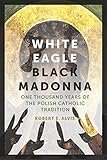White Eagle, Black Madonna : One Thousand Years of the Polish Catholic Tradition / Robert E. Alvis.
Material type: TextPublisher: New York, NY : Fordham University Press, [2016]Copyright date: ©2016Description: 1 online resource (368 p.)Content type:
TextPublisher: New York, NY : Fordham University Press, [2016]Copyright date: ©2016Description: 1 online resource (368 p.)Content type: - 9780823271702
- 9780823271733
- 282/.438 23
- online - DeGruyter
- Issued also in print.
| Item type | Current library | Call number | URL | Status | Notes | Barcode | |
|---|---|---|---|---|---|---|---|
 eBook
eBook
|
Biblioteca "Angelicum" Pont. Univ. S.Tommaso d'Aquino Nuvola online | online - DeGruyter (Browse shelf(Opens below)) | Online access | Not for loan (Accesso limitato) | Accesso per gli utenti autorizzati / Access for authorized users | (dgr)9780823271733 |
Browsing Biblioteca "Angelicum" Pont. Univ. S.Tommaso d'Aquino shelves, Shelving location: Nuvola online Close shelf browser (Hides shelf browser)

|

|

|

|

|

|

|
||
| online - DeGruyter Murder, Inc., and the Moral Life : Gangsters and Gangbusters in La Guardia's New York / | online - DeGruyter City of Gods : Religious Freedom, Immigration, and Pluralism in Flushing, Queens / | online - DeGruyter Strategies for Media Reform : International Perspectives / | online - DeGruyter White Eagle, Black Madonna : One Thousand Years of the Polish Catholic Tradition / | online - DeGruyter Northern Character : College-Educated New Englanders, Honor, Nationalism, and Leadership in the Civil War Era / | online - DeGruyter Bound by Conflict : Dilemmas of the Two Sudans / | online - DeGruyter Corporate Romanticism : Liberalism, Justice, and the Novel / |
Frontmatter -- Contents -- Illustrations -- Maps -- Preface -- A Timeline of Poland's Political and Ecclesiastical History -- 1. Baptized into Christendom (966-1138) -- 2. Chaos and Consolidation (1138-1333) -- 3. Baptized into Power (1333-1506) -- 4. The Promise and the Peril of Liberty (1506-1648) -- 5. Deluge and Illusions (1648-1764) -- 6. Reform, Romance, and Revolution (1764-1848) -- 7. The Gospel and National Greatness (1848-1914) -- 8. From Captivity to Cataclysm (1914-1945) -- 9. From Stalinism to Solidarity (1945-1989) -- 10. From Triumph to Turmoil ( after 1989) -- Acknowledgments -- Notes -- Bibliography -- Index
restricted access online access with authorization star
http://purl.org/coar/access_right/c_16ec
In 1944, the Nazis razed Warsaw's historic Cathedral of St. John the Baptist. "They knew that the strength of the Polish nation was rooted in the Cross, Christ's Passion, the spirit of the Gospels, and the invincible Church," argued Cardinal Stefan Wyszyński in a letter celebrating the building's subsequent reconstruction. "To weaken and destroy the nation, they knew they must first deprive it of its Christian spirit." Wyszynski insisted that Catholicism was an integral component of Polish history, culture, and national identity. The faithfulness of the Polish people fortified them during times of trial and inspired much that was noble and good in their endeavors.Filling a sizable gap in the literature, White Eagle, Black Madonna is a systematic study of the Catholic Church in Poland and among the Polish diaspora. Polish Catholicism has not been particularly well understood outside of Poland, and certainly not in the Anglophone world, until now. Demonstrating an unparalleled mastery of the topic, Robert E. Alvis offers an illuminating vantage point on the dynamic tension between centralization and diversity that long has characterized the Catholic Church's history. Written in clear, concise, accessible language, the book sheds light on the relevance of the Polish Catholic tradition for the global Catholic Church, a phenomenon that has been greatly enhanced by Pope John Paul II, whose theology, ecclesiology, and piety were shaped profoundly by his experiences in Poland, and those experiences in turn shaped the course of his long and influential pontificate.Offering a new resource for understanding the historical development of Polish Catholicism, White Eagle, Black Madonna emphasizes the people, places, events, and ritual actions that have animated the tradition and that still resonate among Polish Catholics today. From the baptism of Duke Mieszko in 966 to the controversialburial of President Lech Kaczyński in 2010, the Church has accompanied the Polish people during their long and often tumultuous history. While often controversial, Catholicism's influence over Poland's political, social, and cultural life has been indisputably profound.
Issued also in print.
Mode of access: Internet via World Wide Web.
In English.
Description based on online resource; title from PDF title page (publisher's Web site, viewed 02. Mrz 2022)


